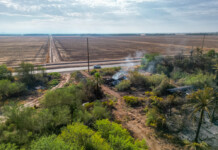
Growing naturally along the Sea of Cortez in Baja California, the San Marcos Hibiscus is a beautiful choice for our yards in Maricopa. Because it is native to the Sonoran Desert, it loves sandy and rocky soil like ours in Pinal County.
As it is a wild cotton — one of the few natives to the Southwest — it is related to domestic cotton from America and Egypt. The cotton plant and Roselle are relatives of San Marcos Hibiscus, all belonging to the mallow family.
Its deep green leaves and pale yellow flowers lend a tropical air to the garden. Five red dots form at the center of the petals where yellow stamens arise. The small fruits contain seeds that can be used for propagation. Tiny threads that look like miniature cotton balls cover the seeds.
This evergreen shrub basically takes care of itself. Just plant it in a sunny spot with well-drained soil. It will do best in the ground because potting soil is too enriched for its simple taste. If fertilizers, amendments or mulch are added, the plant could die.
This perennial needs deep watering twice a month in the summer but little water the rest of the year. Some great features of this plant are its fondness for poor soil, tolerance for salt, blooms from spring to fall, lack of thorns and reflected heat tolerance. It’s also litter free.
With a moderate growth rate, the San Marcos Hibiscus reaches 2 to 4 feet tall and 4 by 6 inches wide when mature. Prune them when necessary to keep a rounded shape or the branches will get lanky.
Although it is frost tolerant at 30 degrees, the roots are hardy at 20 degrees, and it will grow back if damaged. In cooler climates, it will bloom from October to May. Once the temperature reaches 80 degrees in the spring, the flowers will start to appear.
If you’d like to see butterflies in the garden, this hibiscus welcomes them as a host plant. Just watch the Hairstreak Butterflies and Painted Lady Butterflies as they lay their eggs on the leaves or stems. Bees are also attracted to it.
Look for this hibiscus at nurseries that sell desert plants and the Desert Botanical Garden in Phoenix. You will be amazed by this addition to your garden!


![Maricopa restauranteur makes Food Network connection [Namkeen Dhaba]](https://www.inmaricopa.com/wp-content/uploads/2024/04/439456716_377105198650519_7536248579664805896_n-218x150.jpg)










![Maricopa’s ‘TikTok Rizz Party,’ explained One of several flyers for a "TikTok rizz party" is taped to a door in the Maricopa Business Center along Honeycutt Road on April 23, 2024. [Monica D. Spencer]](https://www.inmaricopa.com/wp-content/uploads/2024/04/spencer-042324-tiktok-rizz-party-flyer-web-218x150.jpg)
![Maricopa restauranteur makes Food Network connection [Namkeen Dhaba]](https://www.inmaricopa.com/wp-content/uploads/2024/04/439456716_377105198650519_7536248579664805896_n-100x70.jpg)


